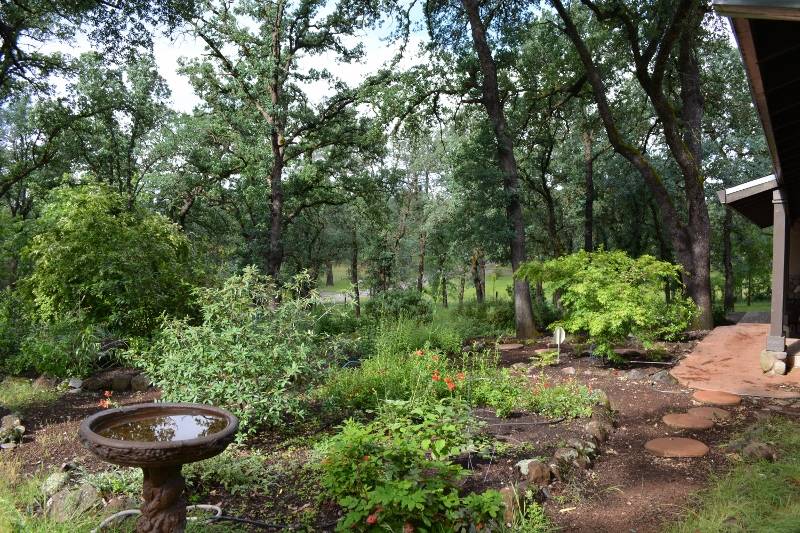
An Island of Our Own


Our front yard in early spring, showing just a few of the 200 blue oaks on the island. Photo by author.
Over the years, Kathy and I have often dreamed of escaping today’s fast-paced, hectic world and moving to an island of our own—an island of trees, flowers, and abundant wildlife, where we could experience the joys of nature without leaving the confines of our own property. Realizing that buying an island wasn’t a realistic option, we decided to do the next best thing and create one on our three-acre patch of oak woodland in the foothills of Northern California.
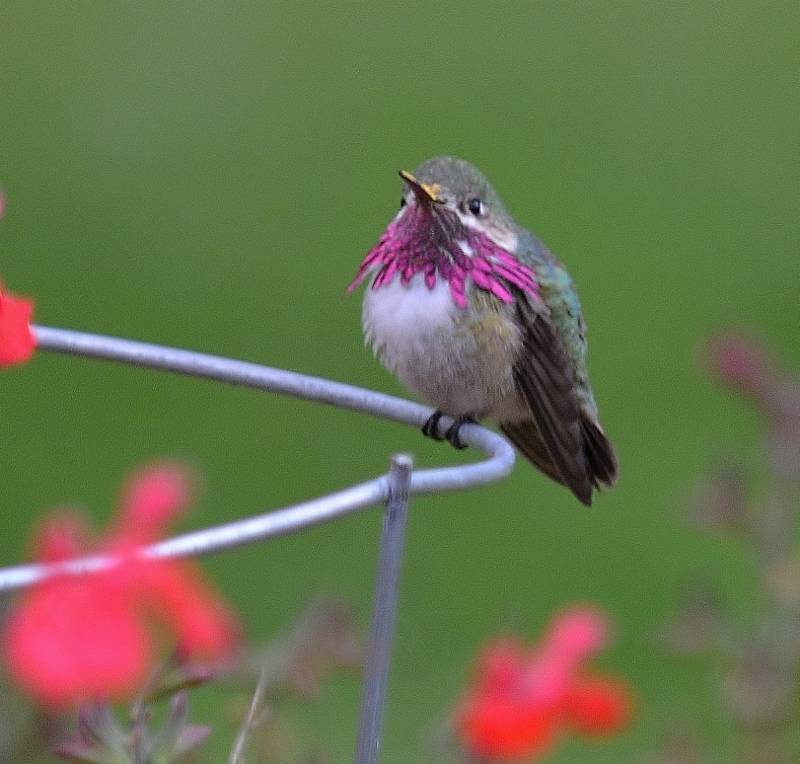

Every spring we receive an extra special visit from a handful of calliope hummingbirds. Calliopes are the smallest of all hummingbirds normally found in the U.S. Photo by author.
Everyone knows you can’t have wildlife without adequate habitat: food, water, cover, and space. With over 200 mature blue oaks and gray pines growing on the island, we already had a good start. Hawks and owls roost and sometimes nest in the branches, while deer, gray squirrels, and wild turkeys feed on the bounty of acorns and pine nuts these beneficial trees provide. All of the wildlife that honor us with their presence take advantage of the numerous birdbaths and water containers we’ve provided. These invaluable water sources are absolutely essential during Northern California’s long, hot summers.
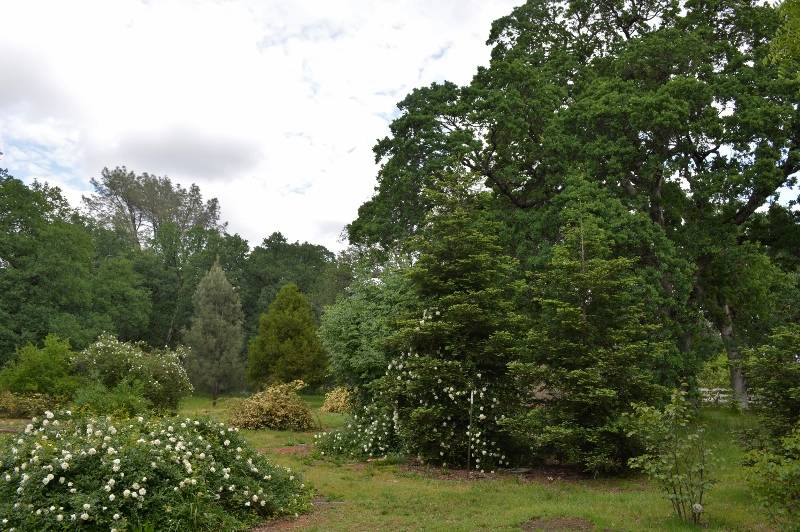

We’ve planted Lady Banks rose brambles throughout the yard to help provide cover and protection from predators. Those shown in the photo are now three times this size. Photo by author.
Our first step in attracting hummingbirds, goldfinches, butterflies, and native bumblebees was ridding our yard of water-guzzling domestic fescue and replacing it with rock gardens of wildlife-friendly plants. Annuals like California poppy, Rudbeckia, Zinnias, and sunflowers offer beauty and sustenance every spring and early summer. Perennials like Verbena, Lantana, Salvia, Penstemon, and Epilobium provide nectar and cover for much of the year.
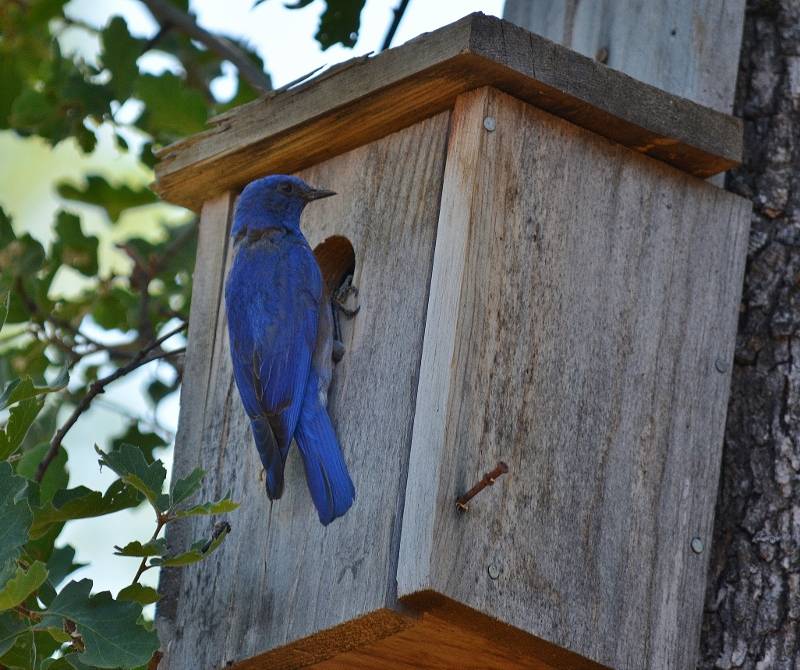

Bluebirds, tree swallows, flycatchers, nuthatches, and other cavity-nesting birds lay claim to the many nest boxes we’ve strategically placed around the island. Photo by Kathy Callan.
Kathy and I never tire of watching Anna’s, rufous, and black-chinned hummingbirds dart in and out of the garden. Once or twice each year, we’re visited by diminutive calliopes. We’ve found that as long as we’re able to provide nectar-producing flowers and attract tiny flying insects to the garden, hummingbird feeders aren’t necessary.
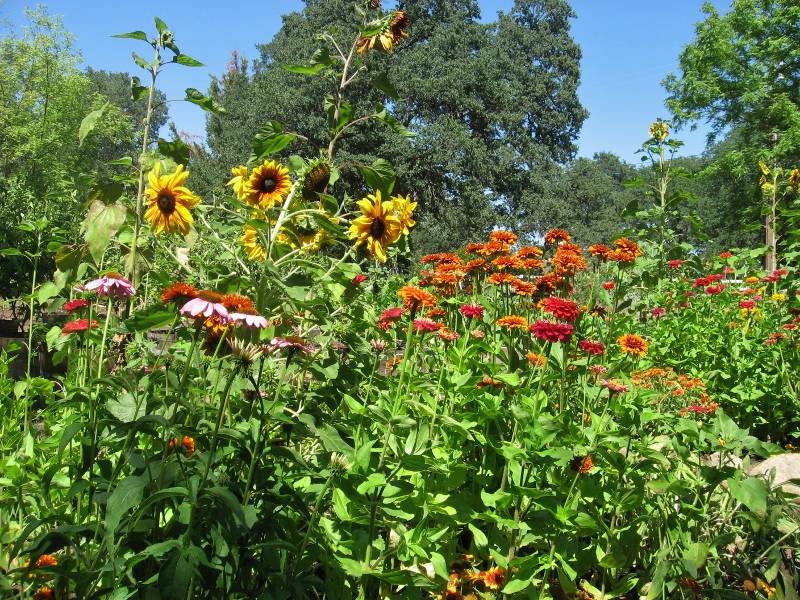

Every spring we roll out the welcome mat for hummingbirds, butterflies, goldfinches, and native bees by planting wildlife-friendly flowers like Zinnias, Rudbeckia, Echinacea, and sunflowers. Photo by author.
During the winter months we fill our seed feeders with nutritious black sunflower seeds that we buy from the local feed store. Sunflower plants, from ten-foot-high mammoths to much smaller ornamentals, serve the same purpose during the summer months, encouraging regular visits from woodpeckers, goldfinches, nuthatches, titmice, and grosbeaks. We never artificially feed deer or other mammals, although the deer do a good job of gleaning what’s left of our tomato garden in the fall. As long as they leave a few for us, Kathy and I are happy to share.
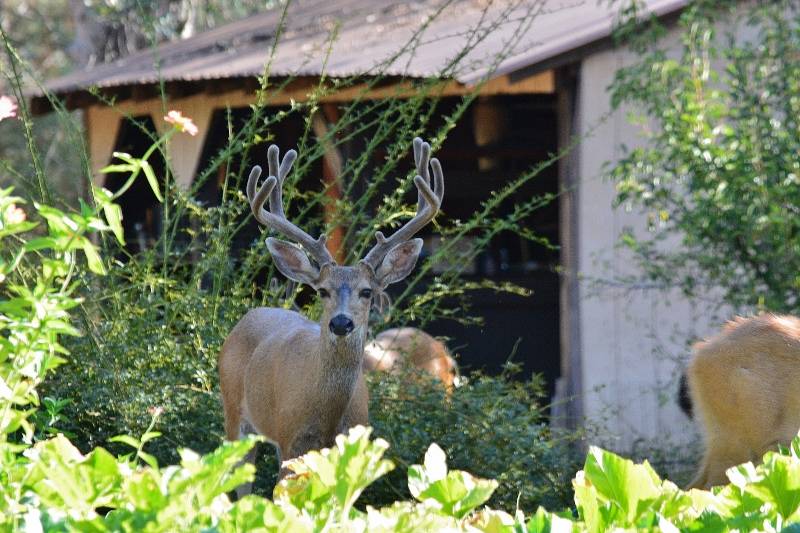

Deer are regular visitors, especially during hot summers when food and water are scarce. We never artificially feed deer but allow them to glean a few tomatoes at the end of the growing season. Several fawns have been born on the island over the years. Photo by author.
Migratory cavity-nesting birds like bluebirds, nuthatches, tree swallows, and flycatchers generally arrive in early spring to claim the various nest boxes I’ve installed in strategic locations around the island. White-crowned sparrows, juncos, goldfinches, robins, and towhees linger for a few months, taking advantage of the healthy menu of seeds, insects, grubs, and other food items, before moving north to cooler environs. (A list of bird species that have graced us with their presence during our thirty-two years on the island is available by clicking this link.)
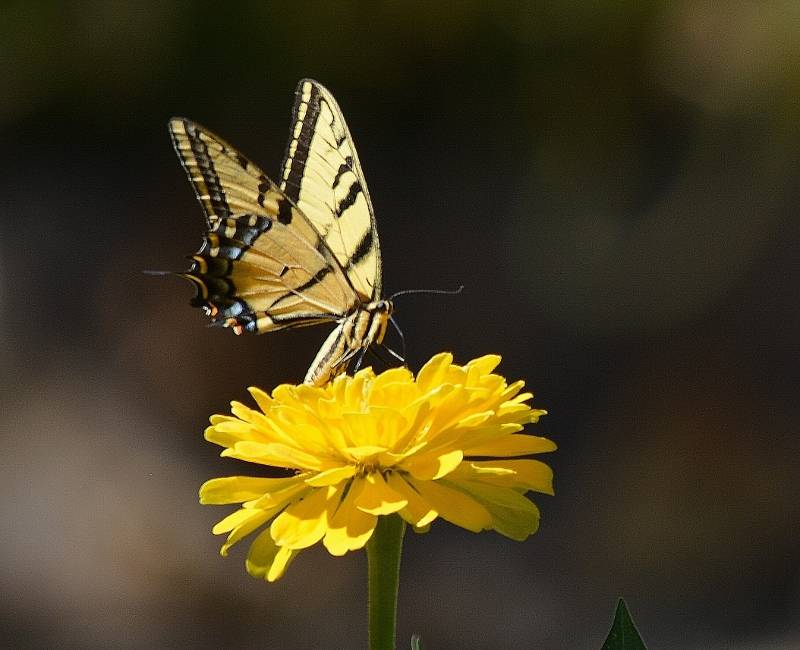

Plant wildlife-friendly flowers and they will come: swallowtails, buckeyes, monarchs, skippers, fritillaries, painted ladies, California sisters, mourning cloaks, . . . Photo by author.
Doves, quail, towhees, and other ground-feeding birds live in constant danger of being snatched up by Cooper’s hawks or ambushed by the neighbor’s cat. I’ve provided cover in the form of thorny Lady Banks rose brambles throughout the yard and brush piles along the perimeter. Fast-growing Lady Banks roses not only provide protection from predators, they also adorn the yard with magnificent displays of yellow and white flowers every spring.
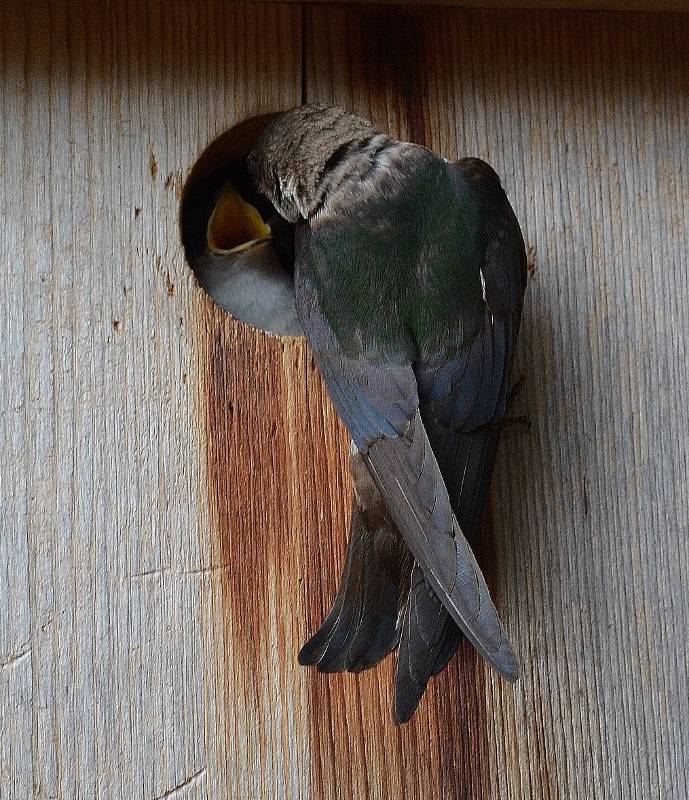

Every winter, I clean out all of the nest boxes and prepare them for new tenants, like these violet-green swallows. Photo by Kathy Callan.
Kathy and I like to say that we’re an equal-opportunity island. All reptiles and amphibians are welcome. Fence lizards, alligator lizards, sharp-tailed snakes, and an occasional gopher or king snake provide us with unending enjoyment during the warmer months. Pacific tree frogs and western toads help to rid the garden of pests.
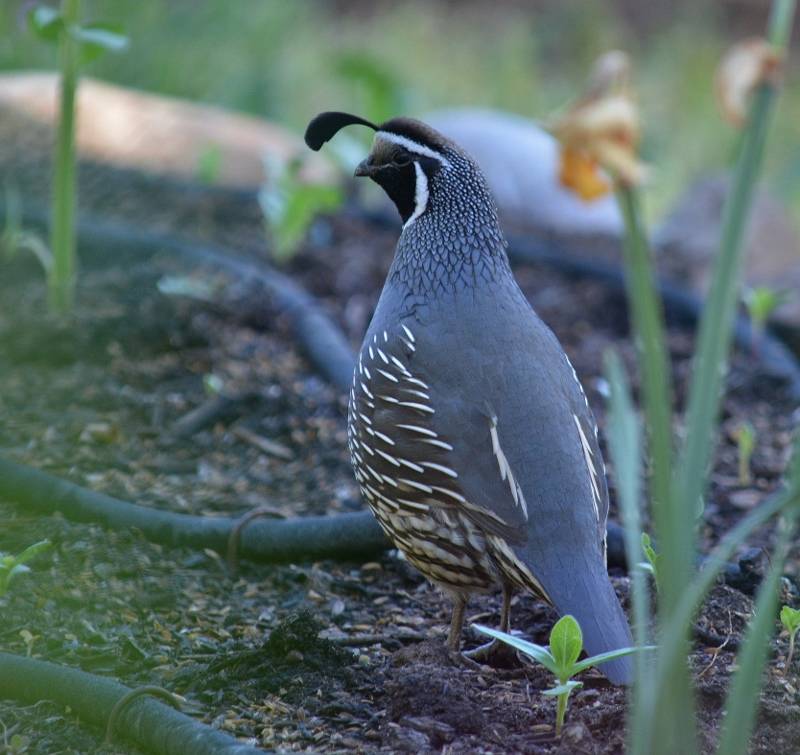

Kathy and I enjoy seeing quail in the yard throughout the year and provide plenty of nearby cover to help keep them safe from predators. Photo by author.
Speaking of pests, we’ve found that natural pest control works remarkably well if you give it a chance. Our resident red-shouldered hawks keep us free of ground squirrels, and owls do a fairly good job of controlling gophers. Since we don’t have a lawn anymore, we don’t worry about moles. Bluebirds, flycatchers, and swallows consume flying insects by day, and bats take over when the sun goes down. Voracious western toads, which patrol the undergrowth at night, can eat as many as 10,000 insects in one summer season.
You don’t have to live on three acres of oak woodland in Northern California to experience the joys of nature. Kathy and I recently visited relatives in LA’s drought-stricken San Fernando Valley and spent several hours strolling through residential neighborhoods. Largely due to water restrictions, many front yards had been converted from traditional lawns and landscaper shrubs to gardens of drought-tolerant native plants, nectar-laden flowers, and wildlife-friendly perennials. Close behind were butterflies, hummingbirds, and, in some cases, native bumblebees.
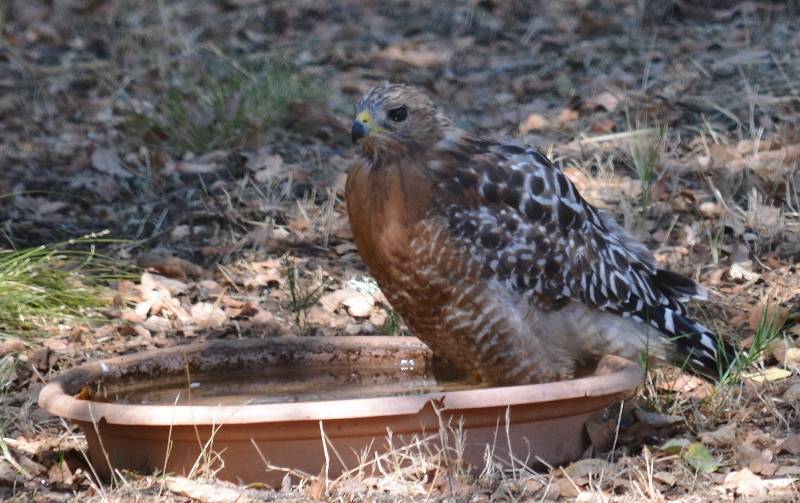

This red-shouldered hawk is escaping the summer heat in one of many water sources we’ve placed around the island. Photo by author.
Want to create an island of your own? The National Wildlife Federation’s Garden-for-Wildlife program, the Audubon Society, or your local native plant society can give you some great ideas. The possibilities are endless.
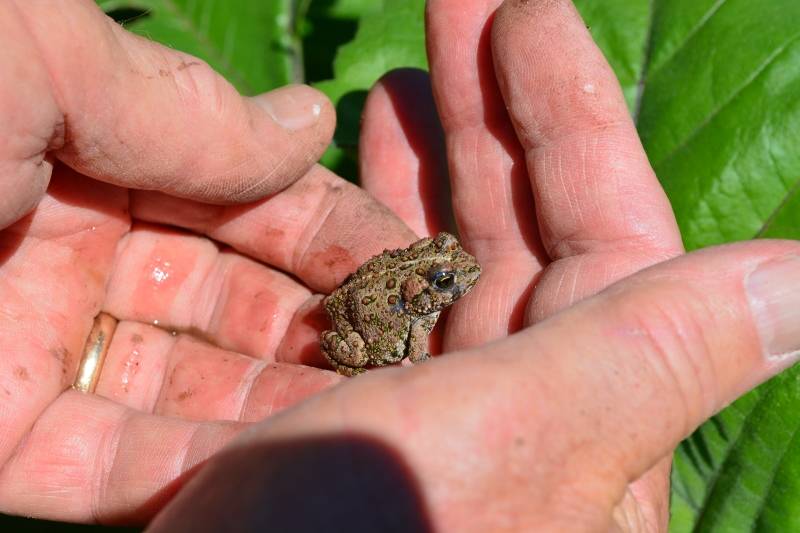

With all the welcome rains we received last spring came a bounty of young western toads like this one. Photo by Kathy Callan.
This piece originally appeared in my September 23, 2016 “On Patrol” column at MyOutdoorBuddy.com. It has been modified for posting on this blog.


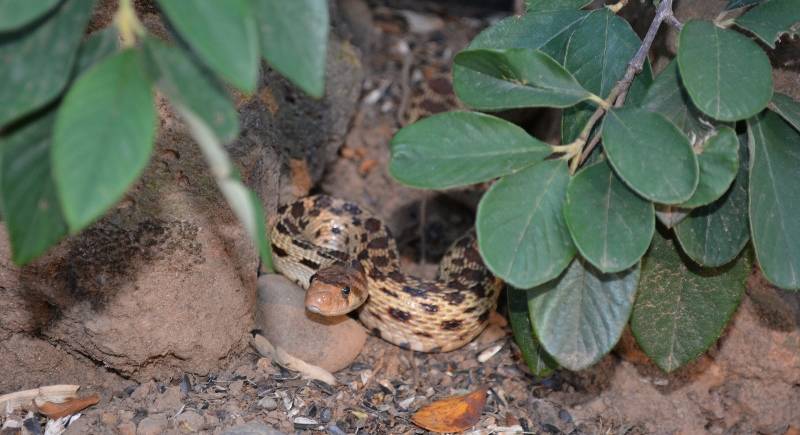
Kit Harvey
Wonderful read and environment you two have created! Lovely, thank you!
Steve
Thank you so much, Kit. That means a lot to us.
Mary Beck
Sounds like a lovely Island you have created!
Steve
Thank you, Mary. It’s been a labor of love.
Donna
Sounds like you have created your own paradise. Great read.
Steve
Thanks so much for your kind words, Donna.
Duane Brovan
Steve nice story and good pictures, you and Kathy are good photographers able to catch animals in their natural setting.. Thanks for sharing
Steve
Coming from a great photographer like you, that’s a wonderful compliment, Duane. Thank you so much.
Ed Atwood
Great article we had hummingbirds, and the mother that looks and acts like them as a kid in West Texas, they came in when our apricot trees started blooming. Keep the article’s coming let me know when your next book comes out. Ed and Bella the devil dog
Ed Atwood
That is moth not mother dang auto spell
Steve
Thank you, Ed and Bella. I’ll be sure to let you know when the next book comes out.
Earle W. Cummings
We are following the same model, but ours is more of an “island in the sky” because we are located on a ridge in the Coast Range near Lake Sonoma. We have had to conserve water, so not quite so many water sources, and for fire safety, I clear a lot of the grassland around us, but the benefit of the regular string-trimming before the introduced annual grasses set seed is that I’m getting a pretty good cover of native perennial bunch-grass. We have valley oaks, black oaks and coast live oaks for acorns, and madrones and manzanitas are berry producers. A few redwoods and gray pines, plenty of douglasfir for cover at a little distance from the house.
Steve
Earle,
That’s wonderful that you’re sharing your space with wildlife. During the coming years, it will be imperative that we do this as more and more habitat is being swallowed up by development.